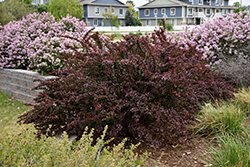Height: 10 feet
Spread: 6 feet
Sunlight:
![]()
![]()
Hardiness Zone: 4a
Other Names: var. atropurpurea, Red Barberry
Description:
A beautiful shrub for bringing color into the landscape; rich plum-purple foliage all summer long, finally turning to a deep amber in fall, also has attractive flowers and showy red fruits after the leaves fall
Ornamental Features
Red Leaf Japanese Barberry is primarily grown for its highly ornamental fruit. The fruits are showy crimson drupes carried in abundance from early to late fall. It has attractive plum purple deciduous foliage which emerges crimson in spring. The small glossy oval leaves are highly ornamental and turn an outstanding coppery-bronze in the fall. It features tiny clusters of yellow flowers hanging below the branches in mid spring.
Landscape Attributes
Red Leaf Japanese Barberry is a dense multi-stemmed deciduous shrub with a more or less rounded form. Its relatively fine texture sets it apart from other landscape plants with less refined foliage.
This is a relatively low maintenance shrub, and can be pruned at anytime. Deer don't particularly care for this plant and will usually leave it alone in favor of tastier treats. Gardeners should be aware of the following characteristic(s) that may warrant special consideration;
- Spiny
Red Leaf Japanese Barberry is recommended for the following landscape applications;
- Mass Planting
- Hedges/Screening
- General Garden Use
Planting & Growing
Red Leaf Japanese Barberry will grow to be about 10 feet tall at maturity, with a spread of 6 feet. It tends to fill out right to the ground and therefore doesn't necessarily require facer plants in front, and is suitable for planting under power lines. It grows at a fast rate, and under ideal conditions can be expected to live for approximately 20 years.
This shrub does best in full sun to partial shade. It is very adaptable to both dry and moist growing conditions, but will not tolerate any standing water. It is considered to be drought-tolerant, and thus makes an ideal choice for xeriscaping or the moisture-conserving landscape. It is not particular as to soil type or pH, and is able to handle environmental salt. It is highly tolerant of urban pollution and will even thrive in inner city environments. This is a selected variety of a species not originally from North America.
Disclaimer - This resource is provided for informational purposes only and does NOT reflect current availability. Inventory varies seasonally, so we cannot guarantee that every plant will be in stock at all times - please contact your favourite GardenWorks location directly for current availability. It does not include our entire inventory of plants, so be sure to visit GardenWorks to see varieties that may not be represented on this list.


